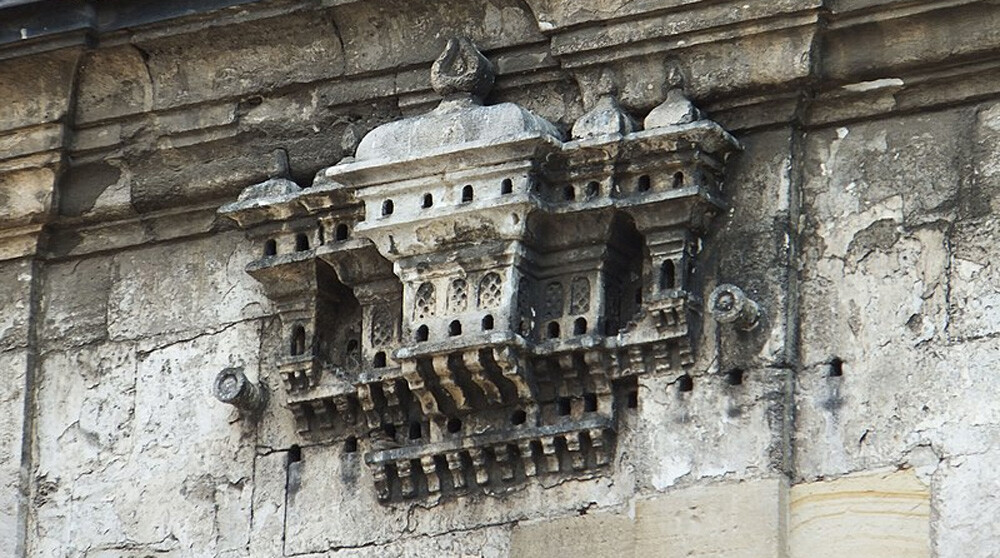4 Badass and Revealing Types Of Art From Around The World

Different cultures reveal their beliefs and quirks in all sorts of ways, including food, sports, religion, politics, and even costumed orgies. Unfortunately, nearly all of those somehow lead to fistfights, but you know what sometimes doesn't? Art. So enjoy the following, and remember that we're all not so different even though we may not look, sound, or achieve orgasm the same way.
Sand Mandalas
Sand mandalas are an artistic representation of Buddhism's ideals composed in the medium of (as some of you may have teased out) sand. A mandala is a mix of designs and symbols that portray a spiritual journey. In addition to looking especially cool while stoned, they help focus the mind and aid in meditation.

They require tens of hours of utmost concentration over numerous days, teaching patience and mindfulness. Yet, despite their beauty and the effort exerted in their creation, they're casually swept away when finished, exemplifying impermanence and the capability to release oneself from earthly and personal attachments.
Check out the badass welcome put on at the UK's House of Commons to celebrate the visit of the 14th Dalai Lama in 2008. We would have just put out a nice cheese plate, but we admit that this is much nicer:

It's what's known as a Chenrezig mandala, named after a Buddhist deity (aka Avalokiteshevara) who personifies compassion and is either portrayed with a thousand arms or, when the artist is getting yelled at by his wife to come to bed, just four arms.
The mandala is a 2-D depiction of a 3-D (or more, if you count mind-melting mental release as a dimension) "divine mansion" in which dwells Avalo … the Buddhist guy. He's surrounded by his sacred retinue and, like all great historical (and historic) art, the mandala is chock-full of hidden meanings, symbols, and everything represents something important to Buddhism. No design is wasted or tacked on cosmetically, and everything is mindfully arranged.

Wonderlane/Wiki Commons
In typical Buddhist fashion, the deconstruction of the sand mandala, or dissolution ceremony, is just as important as its birth. To demonstrate one of the most crucial Buddhist truths, impermanence, the monks ritually dismantle their insanely detailed, laborious artform then dump the sand into a river. Because it's not just the existence of impermanence that's vital—the important thing is our acceptance of it. Plus, this process is like laxative for the universe, helping to dispel negativity.
This cornerstone Buddhist ideal of letting go is helpful at all periods of life, be it the untimely loss of a beloved hamster or the expectation of our own death. But it's all right because our bits, like the sand mandala, will be systematically reconstituted into nature to form new life. And hey, now that you've accepted your own irrevocable doom and your existence as an insignificant, infinitesimally transient puff of cosmic dust, let's look at some birdhouses!
Turkish Birdhouses
Cool historical features are hidden everywhere in cities with prominent pasts, features like the easily missed ones adorning many of Turkey's various civic structures. No, not graffiti, but birdhouses. Those with an eye for architecture may spot them on the facades of homes, bridges, schools, inns, palaces, libraries, tombs, and churches, synagogues, and mosques:

This practice helped imbue all Anatolians, regardless of social standing or age, with love for the natural world and its denizens, be they furred, feathered, or otherwise. As such, these animal-loving peoples showed mercy and compassion to many animals. They founded organizations or charities called Waqf (pronunciation: who the hell knows) where street dogs were fed and cared for, injured storks were rehabilitated, and other creatures, such as wolves, horses, and myriad smaller things, were looked after, fattened, watered, and generally loved. Oh, it's also worth mentioning that doing these things earned people religious credits to ensure them a more comfortable life beyond.
But the Anatolians really loved them some birds and the tradition of municipal birdhousing boomed during the Ottoman period. It dates back at least 600 years, though it may have pre-dated the Ottoman Empire's inception in 1299. It might even be inspired by a more ancient Mughal tradition.

The older houses are of simpler construct. Yet the styles and sophistications evolved over time, and many of them are just as grandiloquent and intricately detailed as the abodes of the sultans themselves. The multi-storied, multi-roomed avian mansions built in the later centuries are definitely nicer than where most of us are living.
They're situated out of the reach of humans as well as Turkey's vigintillion feral cats, in spots that receive lots of photons and not so much wind. Some have water troughs, runways, and even balconies. A number were built in the fashion of palaces, or royal dwellings, while others sported the minarets and domes of stately mosques.

Diatom Art
For old-timey people, the natural world was a source of entertainment and exploitation rather than something to be respected. Hell, they invented an entire type of dog just to run in a wheel and turn their cooking spits. Another, less depressing and torturous example emerged later on around the advent of the microscope: a new artform, made from arrangements of microscopic algae called diatoms.
These microalgae generally range from 5 to 200 microns (a micron is about 1/26,000 of an inch) and are works of evolutionary art in their own right. For single-celled creatures, these teeny-tiny things come in an infinite variety of stunning forms, thanks to their kaleidoscopic glass (silica) shells.

Equally impressive, these itty-bitties aren't simply alive; they're living factories, accounting for about 20% of the oxygen produced each year. And, just to remind you, diatoms are goddamn small: about 100 of them could comfortably fit within an apostrophe with enough room to stretch out.
Diatom artists, who by the early 1800s were presumably bored of beating cats with cudgels, carefully cleaned and arranged the diatoms between plates. Then they slowly positioned each piece with a cat whisker or similarly Lilliputian implement.
Most of the works you see here date to the late 19th century. Wealthier folks with a naturalistic hankering were initially the only ones who could and would afford the new-fangled, potentially satanic microscope that allowed humans to violate God's will and peep the things that He made private.
So the rich folk bought diatom arrangements and threw parties to marvel at the invisible world now so tantalizingly revealed. Not long eafter, technological advancements made the microscope commonly available and affordable, allowing all classes to enjoy "parlor microscopy" and the wonders of the micro-world.
Jingle Trucks
American truckers decorate their rigs with provocative mud flaps, chewing tobacco spit-stains on the driver's side door, and sometimes a coyote wedged into the front grill. But in Pakistan (and neighboring Afghanistan and India), road-warriors adorn their "jingle trucks'' with near-infinite forms, hues, and baubles:

Jingle trucks get their name from the jingles and other onomatopoeias produced by the innumerable chimes, bells, and other flashy danglies that swing from all conceivable (and a few inconceivable) surfaces—these are basically a day-drinking housewife's charm bracelet on wheels.
Overwhelmingly, the trucks feature iconically huge, custom-built wooden prows, or crowns, on their foreheads along with embiggened bumpers to cut a more imposing figure and allow room for extra ostentation.

"Cargo?"
Many trucks also boast portraits on their backsides. These portraits once immortalized anti-Soviet fighters or nationalist martyrs from the Indo-Pakistani wars and skirmishes. But as a sign of changing times, they now feature movie stars, the truck's owner, or family members.

These Bedford trucks came from England in the 1920s and featured corporate logos. Over the following decades, the logos transformed into all sorts of other things. Which ain't cheap: Some truckers spend more on their mechanical steeds than on their houses, even dumping two years' salary (about $2,500 … stay in school, kids) on a paint job. The interiors are just as elaborate, with enough wood paneling, psychedelic lighting, luxurious fabrics, and glitzy glamor to make a Rolls Royce blush.
Such adornments are similar to the previously mentioned birdhouses because they fulfil one of the same purposes: securing one's situation after death. University of Karachi professor Durriya Kazi says that the bedighting one's auto with festive colors and vibrant symbolism is a way to gain religious merit and a big thumbs up from God.

Kazi adds that this is in line with, and inspired by, Sufism, a mystical form of Islam which you may have seen on travel shows, in the form of those whirling dervishes who spin around until they're dizzy enough to see God. In addition to their sacred spinning, Sufi traditionalists also gaily decorate their shrines, as per the jingle trucks' attire.
Artforms like these are generally of the "sadly dying out as people eschew folksy stuff for modern conventions" type. But, thanks to internet fame, a global branching out of jingle artists, and the efforts of people like the aforementioned professor Kazi, jingle trucks are enjoying a renewed fame and a revival. Are you likely to see them plying your local highways and avenues? Perhaps not, but rest assured that this uniquely joyful, uplifting artform won't be disappearing anytime soon.
Top image: Alexandros.Papadopoulos
